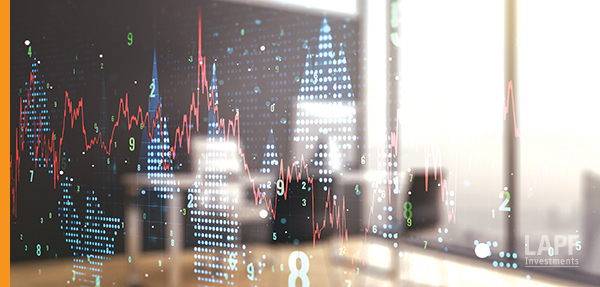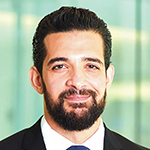The outlook for global equities
Published: June 1, 2022
Written By:

|
Pádraig Floyd |
Pádraig Floyd examines the outlook for global equities in an era of volatile global economics, and finds several reasons for optimism
For about three-quarters of the last 30 years, global equities have returned more to investors than high quality global bonds. The margin of outperformance has been around 12.5%, according to data from Cambridge Associates and that leads many to believe that despite some recent difficulties, equities will outperform high quality bonds again.
Global growth down, but not out
Though global economic growth is anticipated to fall below that experienced in 2021, it is still likely to hit 4% and that’s more than the 3% growth rate of the last few decades.
Central banks are girding their loins in the anticipation of interventions they haven’t made for a considerable time.
But we’re out of Covid-19, and once businesses can restock their bare cupboards, the strong demand in the market will be satisfied once again.
So, there are plenty of opportunities for local authority pension funds (LAPFs) in their global equity portfolios, even if there isn’t very much going cheap.
There’s growth in them there hills
Many companies in global equity portfolios are experiencing a total dislocation between the share price and their fundamental progress, due to increasingly short-term market sentiment and behaviour, says Chris Murphy, client service director at Baillie Gifford.
“In periods of stress, people’s time horizons contract, and the pressure to sacrifice long-term gains for immediate respite grows,” says Murphy. “However, for our LGPS clients, they have the experience, patience and time horizon to ride out market volatility.”
Murphy cites German multinational Delivery Hero as an example. The company is in 50 markets worldwide and has 2.2 billion customers. In the first three months of 2022, it experienced a 50% growth in revenue. It has already seen a four-fold increase in revenues over the past two years, yet its share price has halved.
“We believe it’s worth more than the market says; exactly when that market appreciation comes through is tricky to pinpoint, but when you’re investing on a five to 10 year time horizon you can be patient,” says Murphy.
But Murphy’s teams are not letting the grass grow under their feet. They continue to meet with firms, kick the investment case’s tyres to ensure their reasoning still makes sense and check they remain well capitalised.
“In some cases when teams have revisited an investment case, they found the likelihood of success had actually increased,” says Murphy. “And the sell-off means that we’ve been investing in some great companies that previously looked too expensive when considering our growth hurdles.”
Creative software firm Adobe, online pet food retailer Chewy, and South Korean e-commerce company Coupang are all excellent examples of these types of company, says Murphy.
Strong appetite for global investing
LAPFs have been taking advantage of this situation. Some of Murphy’s LGPS clients are adding to their global equity allocations. They’ve experienced drawdowns and volatile markets before and have confidence in long-term fundamentals. They also know that this can be the worst time to sell.
“For some of those new allocations, there is increased appetite for global impact investing,” says Murphy. “The LGPS timeframe means that the pools can do something with their capital that benefits society, funding companies that are contributing to a better, more inclusive world.
“By its very nature, the long-term equity investing done by LGPS is sustainable investing – providing patient capital to help companies grow consistently over many years, employing people, contributing to the economy and providing services and products that are useful to society.”
Strong, but cautious allocations
That’s not going to change any time soon. Unlike most funds in the private sector, LAPFs are open and a “perpetual” type of long-term investor, says Richard Tomlinson, CIO at Local Pensions Partnership Investments (LPPI).
Even with generous discount rates – depending on the scheme – realistically, the funds need long-term equity returns that beat short-dated rates plus 400 to 500 basis points.
“You’re not going to get there by only Gilts, or even investment grade fixed income,” says Tomlinson. “You need to have a fairly hefty equity or growth type pricing. Not just equity risk, but other things as well.”
LPPI’s client funds are currently running between 40% and 50% in global equities, says Tomlinson, implemented in a more conservative way.
“We look for more defensive cash flows with larger cap more defensive names. With every asset class, we tend to have a more conservative approach.”
This means the portfolio has very little in terms of emerging market exposure, so very little in terms of Chinese equities and relatively cautious in trying to find different ways to access the growth without owning the actual equities.

Beyond ESG to social impact
Since the beginning of the year, there has been a shift in focus as a result of the Russian invasion of Ukraine. Though there was relatively little exposure among LAPFs to Russian equities, there was a considerable amount of reflection on what to do if that happened again.
It helped to refocus attention on social matters as part of the new normal for investment that increasingly places environmental, social and governance (ESG) themes at its heart.
Vontobel believes that its historic focus on sustainability and being carbon neutral since 2009 gives it a very different perspective, and in addition to the climate agenda, clients are focusing on the impact of investments, says Sheridan Bowers, head of UK and Ireland at Vontobel.
“This is a hot topic with TCFD reporting coming in, and we’ve been talking to some funds and pools about how they can have a positive impact through liquid listed equities.”
Within listed equities, this normally focuses on the negative impacts that companies have, but over the past six or seven years, Vontobel has been gathering positive impacts, too.
“If we’re going to invest for a cleaner planet – and to actually achieve net zero – we may have to invest in some areas that are higher polluting now, but which have the potential to deliver that clean future that we need,” says Bowers.
This doesn’t mean focusing on an oil company changing its spots, but rather something like a wind turbine. It is very carbon intensive to manufacture the steel, concrete, etc. required to install it, but over its operational lifetime, it will produce clean energy, which more than four times outweighs the actual implicit costs at the outset.
“When you put together the carbon impacts of manufacturing and selling those products, then the carbon that can be avoided through the use of that product, you can look at avoided emissions and add a sort of lifecycle management,” he says.
Impact through listed equities
Measuring social impact is far more difficult in listed companies, but it is possible and can allow investors’ portfolios to have a wider reach, says Bowers.
“Many local government and other clients are taking initial steps here where they see a real tangible change through investing in real assets such as social housing. But you can also have that through investing in companies,” he says.
For instance, in certain markets, by investing in financial services companies that are making bank accounts available to women and also financial education to help them become more independent.
Investing in education companies helps people develop their knowledge and become more independent. These produce tangible results that have a social impact, too, through a listed global equity portfolio.
Vontobel has produced an interactive calculator that will allow a member investing in a defined contribution or local government fund to determine the impact of its investment.
“We find ourselves in a great space now because there’s so much more discussion on these matters,” adds Bowers. “And as with everything else, it is essential to ensure clients understand what’s most important for them, what’s real, and then how they can align with it.”
ESG the mantra of the long-term investor
Some may argue that ESG is simply the industry’s way of articulating long-term investing. Certainly, before long it won’t be seen as a different objective, but a fully integrated element of every investment strategy.
“We believe in the idea that taking a very long-term approach to investing, basically ignoring stock markets most of the time, embeds the interests of society alongside the interests of investors,” says Murphy.
“The essential belief is that companies that abuse the environment, treat staff poorly or damage the fabric of society will, within a relevant investment horizon, be regulated out of profitability or deserted by their customers. Therefore, consideration of such factors must form an integral part of any credible long-term investment process.”
Digitalisation across all sectors has presented investors with more global growth opportunities in the last 12 months than in the past decade, says Murphy.
Digital disruption started with retail, media, advertising and entertainment, but is spreading and transforming all sorts of industries such as food, transport, finance, health and materials.
“We know the world continues to progress and the pace of innovation is incredible, so we are optimistic that some of these companies have the potential to be big winners in the future,” he adds.
More Related Content...
|
|
|




